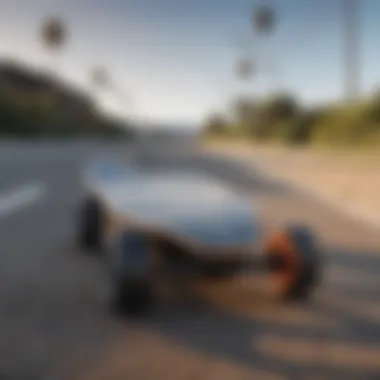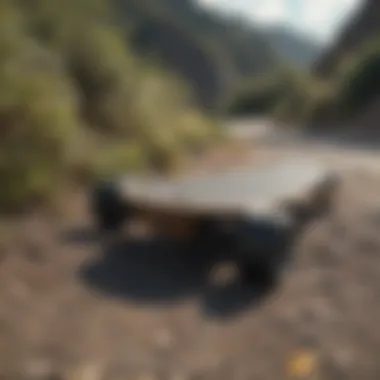Understanding Electric Longboard Speed Metrics


Intro
Electric longboards have transformed the landscape of personal transportation and recreation, mingling technology with thrill. For anyone considering these machines, understanding their speed capabilities is pivotal. This knowledge goes beyond simple numbers; it involves a myriad of factors like design choices, battery capabilities, terrain influences, and user skills. As electric longboarding evolves, potential riders must grasp these concepts to fully appreciate the experience and make informed purchasing decisions. This article aims to deep dive into the fundamentals of speed associated with electric longboards, relevant to both beginners and seasoned enthusiasts.
Surf Gear and Equipment
Navigating the world of electric longboards can be like riding a wave—smooth and thrilling when you know what to expect. To get the most out of your ride, understanding the right gear is essential.
Latest Longboard Technologies
The technology driving electric longboards today is lightyears ahead of where it once stood. Battery advancements have played a crucial role in enhancing speed and efficiency. Lithium-ion batteries, for instance, provide higher energy density, allowing for longer rides without the constant worry of running out of juice mid-journey. Moreover, regenerative braking is becoming standard; this tech not only decelerates riders safely but also helps recharge the battery using energy that would otherwise be wasted.
Each model varies in its design. Aboard a Boosted Board, for example, riders can reach top speeds of around 24 mph, while some custom builds can push beyond the 30 mph mark. Be mindful though; the board's speed isn’t solely determined by the hardware but also the rider's weight and riding style.
Essential Accessories for Riders
An electric longboard needs more than just a quality deck and wheels. Here’s a rundown of some essential accessories that can enhance your riding experience:
- Protective Gear: Helmets, knee pads, wrist guards—safety first! These are not just optional; they are necessary to mitigate the risks of potential slips and falls.
- Portable Charger: If you're planning on taking longer rides, having additional charging options can keep your board rolling instead of sitting idle.
- Quality Footwear: Enough cannot be said about the right shoes. Opt for snug-fitting sneakers that offer grip and support, giving you complete control.
- Riding App: Various apps can track your speed, distance traveled, and even battery life, making it easier to assess your performance on each ride.
Your trip on an electric longboard can be both exhilarating and enjoyable when equipped with the right tools.
Techniques and Skills
Understanding the nuances of riding techniques can drastically affect your speed and overall safety on an electric longboard.
Acceleration Techniques
Finding the sweet spot for acceleration is a skill. Smooth initiation can lead to better control. Start with gentle movements and gradually increase your power; many riders find it useful to practice acceleration on safe, flat terrains before hitting more challenging paths.
Safety and Riding Etiquette
Being fast on an electric longboard might be thrilling, but it does come with responsibilities. Observing terrain conditions and being cognizant of other road users is critical. Whether it’s maintaining awareness of pedestrians or abiding by local laws regarding electric vehicles, practicing good etiquette enhances the experience for everyone. Riders should always signal their intent when turning, as this keeps the lanes safe and encourages a respectful community.
Riders must not only be aware of their speed but also to whom they share the roads and paths. Safety first ensures that the ride remains enjoyable for all.
As a community, electric longboarding continues to flourish. By understanding speed metrics, adopting essential gear, and honing necessary skills, you can truly unlock the potential of electric longboarding, making your journeys both swift and secure.
Foreword to Electric Longboards
Electric longboards have carved a unique niche in the world of personal transportation, offering an engaging blend of speed and convenience for riders. Their growing popularity stems from their ability to effortlessly whisk individuals along urban landscapes, making them an appealing choice for commuters and leisure riders alike. Understanding the nuances of electric longboards isn't just about knowing how they work; it encompasses their evolution, types, and how specific features influence speed, which is crucial for potential buyers and enthusiasts.
The significance of this section lies not only in familiarizing readers with what electric longboards are but also in laying the groundwork for deeper explorations into their mechanics and performance. Each facet of the electric longboard experience—from design advancements to user preferences—affects how speed is perceived and utilized. With that in mind, let’s dive into what electric longboards are and how they’ve progressed over the years.
Definition and Evolution
Electric longboards are essentially skateboards with integrated electric propulsion systems, allowing riders to accelerate without relying solely on leg power. They can reach impressive speeds that a traditional longboard could only dream of, often exceeding 20 miles per hour depending on the model.
The evolution of electric longboards can be traced back to simple motorized skateboards in the late 1970s and early 1980s. However, it wasn't until recent technological advancements, particularly in battery efficiency and motor performance, that electric longboards gained mainstream traction. Riders now benefit from compact designs, improved safety features, and a variety of riding modes catering to different skill levels.
Categories of Electric Longboards
Electric longboards come in several flavors, each tailored for specific riding styles and environments. Recognizing these categories helps riders choose the right board that aligns with their needs.
Street Electric Longboards
Street electric longboards are designed primarily for urban settings, making them a top choice for city dwellers. Their key characteristic is agility; built with a sleek profile and responsive steering, they can zip through traffic and navigate tight spaces with finesse.
The unique feature of street electric longboards lies in their smaller wheels and lightweight build, which enhance maneuverability. However, this design may sacrifice some stability, particularly when navigating uneven pavement or going downhill. For an everyday commuter, these boards offer both speed and ease of use, making them a favored option for bustling city life.
All-Terrain Electric Longboards
In contrast, all-terrain electric longboards are robust beasts that tackle a variety of surfaces, from gravel trails to forest paths. The key characteristic of these boards is their larger wheels and enhanced suspension systems, which provide a smooth ride over rough terrain.
What sets all-terrain boards apart is their capability to handle diverse riding conditions without compromising performance. However, they tend to be heavier and bulkier than street versions, which may be a disadvantage for urban riders who prioritize portability.
Commuter Electric Longboards
Commuter electric longboards are the Swiss army knives of electric boards, designed with the rider's daily journey in mind. These boards typically feature balanced speeds and battery life, catering to short to medium commutes.
The standout aspect of commuter boards is their versatility; they often come equipped with features such as headlights, taillights, and even integrated GPS for navigation. While they may not reach the ultimate top speeds of high-end models, their consistency and reliability make them a smart choice for riders looking for practicality above all.


Understanding these categories helps riders make an informed decision that suits their lifestyle, ensuring optimal satisfaction with their electric longboarding experience. As we see the technology around electric longboards continuously improve, we must also consider how speed metrics play a role in shaping these innovations.
Key Factors Influencing Speed
When we talk about the speed of electric longboards, a bunch of key factors come into play that drastically affect how fast these boards can really go. Understanding these elements is vital, especially for anyone looking to purchase or ride an electric longboard. Speed isn’t just about how quickly you can travel; it also encompasses how efficiently a board can maintain that speed under various conditions. Here’s a rundown of the major players in this thrilling game of speed.
Motor Power and Type
The heart of any electric longboard is its motor. The power output largely determines how fast the board can go. Motors typically come in two flavors: hub motors and belt-driven motors. Hub motors sit inside the wheels, which gives a clean and quiet operation. But, don’t let that silence fool you; these motors can pack a punch. On the other hand, belt-driven motors often provide more torque and better acceleration, making them fantastic for hilly terrains.
High-power motors, usually between 1500 and 3000 watts, can give you those adrenaline-pumping speeds that riders crave. Remember, it's not just about the raw power; the motor type can influence efficiency and how well the board handles on different terrains.
Battery Capacity and Voltage
Battery specifications are another crucial aspect. More capacity in amp-hours (Ah) means a board can run for a longer time. Voltage plays a vital role here too; higher voltage can lead to faster speeds. For instance, a 12S battery system (which means 12 cells in series) typically provides more speed and less voltage sag under load than a 10S system. However, there's a balance to achieve; too much voltage can strain the components, leading to decreased lifespan.
Taking into account the type of battery—Lithium-ion batteries are the most common—can also shed light on performance. They generally offer a good balance of weight, performance, and longevity.
Weight and Rider Factors
The combined weight of the rider and the board itself can impact speed in a few significant ways. Here’s a more detailed breakdown:
Rider Weight
Rider weight is a massive factor when figuring out how fast an electric longboard can go. Heavier riders may find that the board struggles to hit maximum speeds, especially when facing uphill. Some boards even have a weight limit, and exceeding that can lead to a sluggish ride, affecting both performance and safety.
What’s interesting is that different boards are designed for different weight classes, making it essential to choose one that suits your body type. Ultimately, finding the right board can mean the difference between a thrilling ride and a laborious challenge.
Board Weight
Board weight is equally important. A lighter board tends to accelerate faster and can reach higher speeds with less effort. On the flip side, heavier boards often offer more stability, especially at high speeds or when navigating tricky terrain. For those who plan to take their longboard on adventures, finding a balance between portability and stability is key.
Rider Skill Level
Rider skill level rounds off this triangle. Novice riders might find themselves struggling to control faster boards, while experienced riders can harness the potential of high-speed capabilities. A skilled rider knows how to lean into turns, respond to sudden stops, and manage throttle effectively, which all plays into how fast they can go safely.
In a nutshell, each of these factors interacts in unique ways, impacting the overall speed and performance of an electric longboard. Whether you are a seasoned pro or looking to make your first purchase, understanding these elements can help you choose wisely and experience the thrill of electric longboarding to its fullest.
Speed Metrics of Electric Longboards
Understanding the speed metrics of electric longboards is essential for anyone looking to purchase or ride these innovative boards. Speed metrics encompass various factors that directly influence how fast an electric longboard can go, how quickly it can reach that speed, and how these numbers hold up under different riding conditions. Knowing these specifics not only helps enthusiasts make informed choices but also assures a safer and more enjoyable experience.
Typical Maximum Speeds
Maximum speed is often the first consideration for thrill-seekers as well as commuters. The typical range of speeds for electric longboards varies based on design and technology but usually falls between 15 to 30 mph. For example, while some commuter boards are designed for a smooth ride and stick around 15 mph, certain high-end models targeted toward experienced riders can rocket past 30 mph!
This speed variation can stem from several factors:
- Motor Size and Type: Bigger motors typically mean higher potential speeds.
- Battery Power: A higher voltage battery can deliver more power to the motor.
- Design Specifics: Aerodynamics play a role. Sleek designs help lessen wind resistance, enhancing speed.
Riders must also consider external factors that can influence these speeds, such as rider weight and board weight, which we'll delve into later. What’s crucial to remember is that each rider’s experience will vary, and what feels fast to one may not feel the same to another.
"Electric longboards can be likened to cars; some are built for speed, while others prioritize comfort and efficiency. Understanding your board's speed capabilities can enhance both your riding experience and safety."
Acceleration Capabilities
Acceleration is the rapidity with which an electric longboard can achieve its top speed, and it’s a quality that riders often overlook. Good acceleration can greatly enhance the riding experience, making it essential for activities like navigating crowded urban environments or quickly getting away from standstill traffic.
The acceleration characteristics can be summarized based on the following:
- Motor Configuration: Dual motors often allow quicker acceleration versus single-motor setups.
- Feature Options: Some boards have settings that give the rider control over power delivery, making it easier to manage swift take-offs and smoother stops.
- Rider Experience: A skilled rider can take better advantage of an electric longboard’s acceleration capabilities.
Unlike maximum speed, which can be a simple number, measuring acceleration isn’t always straightforward. Different brands may report acceleration times in various ways, such as time taken to reach a specific speed. This can complicate comparisons between models. For instance, one brand may claim that their model accelerates to 20 mph in five seconds, while another does it in four.
Therefore, understanding each board's acceleration involves not just looking at specs but also considering personal riding style. Those who enjoy leisurely rides may prefer smooth, gradual acceleration, while thrill-seekers might look for a board that can launch them forward in an instant.
Terrain and Environmental Impact
One major consideration about terrain is how it affects acceleration and top speed. Riders must adjust their expectations based on the condition of the ground beneath them. For instance, navigating up a steep hill requires different power and control compared to gliding smoothly along a level road. Likewise, environmental aspects such as wind and surface conditions can dramatically impact the overall performance of electric longboards, making it essential for riders to be aware of their surroundings.
Effect of Different Terrain Types
Hills and Inclines


When it comes to hills and inclines, they present a unique set of challenges and benefits. Riding uphill is often regarded as an indicator of a longboard's power and efficiency. The key characteristic here is the motor’s ability to handle increased resistance while maintaining speed. When traversing steep slopes, a high-torque motor becomes indispensable. This capability not only allows for upward travel but also influences the rider's confidence levels.
Moreover, going downhill can trigger a rush of adrenaline, leading to higher speeds. This exhilarating experience is tempered by the singular feature of potential danger; without proper control, descent can quickly become a risky endeavor. Riders must consider braking systems as well to manage speed effectively, particularly when on steep grades. As such, hills and inclines can be seen as both a beneficial and challenging aspect within the broader context of electric longboarding performance.
Flat Surfaces
Conversely, flat surfaces provide a very different riding experience. These areas enable riders to achieve maximum speed with minimal resistance, making them a favorite for many longboard enthusiasts. The key characteristic of flat terrain is the consistent surface that allows for smoother rides. It focuses riders on speed and performance metrics, free from the interruptions that inclines might present.
On flat ground, longboards equipped with powerful motors can showcase their full potential, leading to impressive acceleration and sustained velocity. However, the unique feature is that flat terrains can sometimes get monotonous, lacking the excitement that comes with varied elevations. While speed may be maximized, the thrills of navigating curves and obstacles are often diminished. Riders need to balance their desire for speed with the dynamic experience offered by different terrains.
Off-Road Conditions
Off-road conditions take riders on thrilling adventures, but they also introduce variability that can affect speed dramatically. Riding on trails or uneven surfaces requires electric longboards built for durability and adaptability. The key characteristic of off-road conditions is varied and unpredictable terrain. Riders encounter rocks, roots, and other natural obstacles, presenting unique challenges.
These environments can be exciting, allowing for exploration outside paved roads. The unique feature of off-road riding is the enhanced versatility of specific longboard models, designed with rugged wheels and robust suspension. However, this comes with a cost – off-road conditions can often limit speed due to increased friction and the need for more careful navigation. While speed may not be as high as on flat surfaces, the added experience of maneuvering through nature provides a different kind of thrill that many riders cherish.
Weather Conditions and Speed Variability
The Role of Wind
Wind is an often-overlooked factor that can have a substantial impact on the speed of electric longboards. It can either enhance or hinder performance based on its strength and direction. The key characteristic of wind is its ability to create drag; a strong headwind can considerably slow a rider down, while a tailwind can boost speed dramatically.
Understanding wind patterns can lead to more effective route planning. Riders can take advantage of favorable winds during specific times of the day or in certain locations, thereby maximizing their speed. However, excessive winds can also present stability challenges, making it crucial for riders to adjust riding techniques accordingly.
Surface Wetness
Surface wetness is another factor that can significantly impact longboard performance. Wet surfaces reduce the traction between the wheels and the ground, raising the risk of slipping or losing control at high speeds. A key characteristic of wet conditions is that they can alter a rider's tire maintenance needs. Many riders often switch to all-terrain tires or consider specific settings in their boards to better handle slippery conditions.
Riding on a wet surface encourages a more conservative approach to speed, as safety becomes the priority. The unique feature of surface wetness is its ability to transform familiar landscapes into new challenges, adding an element of unpredictability to the riding experience. While it might lower speeds, it can potentially enhance a rider's skills as they learn to adapt to changing conditions.
Ultimately, considering the factors of terrain and environmental impact is essential for optimizing the electric longboarding experience. Different surfaces and weather conditions can dramatically shape a rider's speed and overall enjoyment, making awareness and adaptation crucial for both novices and seasoned riders alike.
Comparative Analysis of Models
When diving into the world of electric longboards, a comparative analysis of models becomes crucial for understanding performance, speed, and overall value. This section highlights the significance of choosing the right model based on personal needs and performance expectations. With a myriad of options available, each designed with different capabilities, features, and price points, prospects can better navigate their choices and find the perfect match.
A thorough analysis helps riders to grasp the distinctions between what entry-level models offer versus what the high-end versions bring to the table. One can not only identify the technical specifications but also understand how those specs translate into real-world performance. This understanding is pivotal for making informed decisions while considering factors like acceleration, range, and durability.
Entry-Level Models vs. High-End Models
When weighing entry-level electric longboards against high-end counterparts, many aspects need evaluation.
Entry-Level Models:
These boards are often seen as gateways into the sport. They have lower price tags, making them attractive for those looking to try things out without breaking the bank. However, the simplicity comes with some trade-offs. For instance:
- Limited speed capabilities
- Weaker motors, often in the range of 250 to 750 watts
- Poor acceleration, sometimes feeling sluggish on inclines
While they serve well for beginners, seasoned riders may find them lacking in performance. Yet, as a first board, they offer a great way to learn the ropes, test balance, and get a feel for electric longboarding.
High-End Models:
In contrast, high-end models pack a powerful punch. They are engineered for optimal speed and performance:
- Superior motor power, often exceeding 1500 watts
- Fast acceleration and remarkable climbing ability
- Enhanced battery life, enabling long rides without frequent charging
Although they demand a heftier investment, the performance rewards can be substantial. Enthusiasts who appreciate speed and challenging terrains lean towards these models as they tightly integrate advanced technology for a superior riding experience.
Popular Brands and Their Speed Ratings
Various reputable brands offer a diverse selection of electric longboards tailored to different riding styles, preferences, and expected speeds. Some standouts include:
- Boosted Boards: Known for their top-notch build quality and impressive speed ratings, these boards can reach up to 24 mph under optimal conditions.
- Evolve Skateboards: With off-road capabilities, Evolve's models provide a versatility that can reach similar speeds on different terrains.
- Meepo Boards: Reputable for being budget-friendly while still offering powerful specs, reaching up to 30 mph, Meepo targets a growing audience that wants speed without premium costs.
This range emphasizes that speed ratings can vastly vary even among the same category, making it essential for buyers to review specifications and real-world usage experiences.
Key Takeaway: The comparative analysis of electric longboard models facilitates informed choices tailored to individual riding needs, whether one is a newcomer or an experienced rider. Proper consideration of features beyond just speed can significantly enhance one's electric riding journey.
Safety and Speed Considerations
The thrill of riding an electric longboard, zipping down streets or gliding over smooth terrain, can be exhilarating. However, as the famous proverb goes, "with great power comes great responsibility." This rings especially true in the realm of electric longboarding where safety is paramount. In this section, we will dissect the interplay between speed and safety, understanding their importance for both new and seasoned riders.
Importance of Protective Gear
When it comes to riding an electric longboard, protective gear isn't just an option—it's a necessity. Think of it as a safety net beneath a high-wire act; it may not be needed every time, but when it is, you’ll be glad it's there. Here are some essential pieces that every rider should consider:


- Helmet: A good-quality helmet is non-negotiable. A fall at high speeds can lead to serious head injuries. Wearing a helmet reduces the risk significantly.
- Knee and Elbow Pads: These might seem a little awkward at first, but they can save your joints from serious damage, should you tumble.
- Wrist Guards: Given the nature of falls while longboarding, your wrists are at a high risk of injury. Protecting them is key to ensuring you keep on riding.
- Gloves: While they may not seem essential, gloves add both grip and protection.
When gear is discussed, a common sentiment arises, "It’s better to have it and not need it than to need it and not have it." This sentiment shines brightly under the sun of safety.
Legal Speed Regulations
Another significant aspect to consider in the context of electric longboards is legal speed regulations. Each region might have its own rules about how fast you can go and where you can ride. Understanding these regulations helps riders enjoy their sport without running afoul of the law. Here are a few points to keep in mind:
- Local Laws Vary: Some states or countries impose strict limits on maximum speeds for electric longboards. For instance, places like California often cap speeds at around 15 mph on public roads.
- Permitted Areas: Not all locations are legally permitted for riding. Knowing where it's acceptable to ride can help you avoid fines.
- Insurance Considerations: Riding in compliance with legal regulations may also affect your insurance coverage, particularly if you have liability considerations in mind.
Understanding the regulations can feel like reading a dense manual, but it's crucial—not just for your own safety, but for the safety of everyone around you.
Rider awareness of speed and surroundings cannot be overstated. It’s not just about the rush but also about riding responsibly.
User Experience and Feedback
User experience and feedback hold a pivotal role when assessing the speed and performance of electric longboards. These factors provide insights not just into how a board performs in theoretical conditions, but also reveal how real users interact with their longboards day-to-day. When considering a purchase, potential buyers often turn to personal stories and reviews, which can significantly influence their decision-making process. Insights shared by users can unearth both the joys and pitfalls of different models, offering a nuanced view that specifications alone may not convey.
An electric longboard can look great in ads and sound impressive on paper, but how it feels on the road is where the true test lies. Specific elements come into play here, including reliability, handling at high speeds, and the overall enjoyment of riding. By gathering feedback from a variety of riders, we can understand these boards not only as machines but as instruments that enhance experiences.
Rider Testimonials on Speed
Rider testimonials are a treasure trove of information that paint a vivid picture of what it's like to zip around on an electric longboard. Many users have shared their exhilarating experiences, highlighting that nothing quite compares to the rush of acceleration and the sense of freedom that comes from riding. For instance, one user mentions feeling like they’re flying while racing down a hill on their Boosted Board, a popular choice among speed enthusiasts. The thrill of hitting maximum speeds of up to 24 mph can feel liberating, but riders also learn about the limits and capabilities of their equipment through these stories.
"Riding my electric longboard is like dancing with the wind. One minute I'm coasting, the next I'm darting down a hill, and it's all thanks to my board's solid performance and speed!" - Enthusiastic Rider
Other strong testimonials also reflect how user skill level influences speed perception. Some riders, particularly novices, may start slow and gradually build confidence, feeling quite different after mastering the basics. On the flip side, there are those seasoned riders who relish the chance to push their boards to the max, finding joy in tuning their boards for speed and performance.
Common Challenges Faced by Riders
While riding electric longboards can be a thrilling experience, it’s not without its challenges. Users frequently report issues that can dampen the thrill of speed. Some of these issues include:
- Battery Life: Riders often realize that as they push for speed, battery drainage can become a concern. Users who expect to travel long distances at high speed might find themselves needing to charge more often than anticipated.
- Hill Climbing: Navigating inclines can be tricky for certain models. Even though some electric longboards are engineered with hill-climbing capabilities, every rider has a different weight, and this can impact performance. Some riders have suggested that knowing the limits of their boards becomes essential during steep climbs.
- Weather Sensitivities: Rainy or wet conditions can alter the board's grip and performance, creating safety concerns. Riders frequently emphasize the need for weather-appropriate gearing and that they need to be cautious about speed when the roads are slick.
These communal experiences collectively build a narrative that potential buyers can benefit from. They enhance the understanding of what it truly means to be a part of the electric longboarding community, highlighting how speed isn't just a number; it’s a combination of excitement, skill, and thoughtful consideration of the ride. With this hand-in-hand perspective of user experiences and their challenges, both new and seasoned riders can navigate the fascinating world of electric longboards more effectively.
Future Trends in Electric Longboard Technology
The electric longboarding scene is increasingly pulsating with developments, fostering a blend of speed, safety, and sustainability. Understanding these future trends can not only inform riders about what to expect but also help them make educated choices when considering their next investment. Keeping an eye on emerging technologies is crucial, as these innovations can significantly enhance the riding experience, making it both more exhilarating and reliable.
Advancements in Motor Technology
Motor technology is on the brink of revolution. As manufacturers continue to push boundaries, we see the introduction of more efficient brushless motors. These motors can provide better torque at various speeds, allowing riders to experience smoother accelerations. Better efficiency means greater energy consumption management, leading to longer rides without the need for frequent battery charging.
Additionally, we are witnessing the integration of regenerative braking systems in many new models. This helps to reclaim energy that would normally be lost during braking, providing an extra boost to battery longevity. Interestingly, some longboards are now being equipped with powered hubs, giving them the ability to operate in a more compact design without sacrificing performance. It's akin to turning a traditional bike into an electric one, but with a sleeker, more skateboard-like feel.
Battery Innovations and Speed Enhancements
Battery technology is another key area where significant advancements are shaping the future of electric longboards. Recent innovations in lithium-ion batteries have paved the way for reduced charging times and enhanced energy densities. For riders, this means shorter downtimes and longer rides. Imagine not having to pause for long, all while speeding down a scenic route.
Furthermore, manufacturers are exploring alternative battery materials, such as solid-state batteries, which promise to deliver higher capacities and increased lifespan compared to conventional options. These new battery types not only facilitate greater speeds but also reduce the overall weight of the longboard, making them more maneuverable and easier to handle. The lighter the board, the better it performs in terms of acceleration and agility.
"With every advancement in battery technology, we inch closer to longer, faster, and more enjoyable rides. The electrifying future of longboarding is right around the corner."
In summary, as electric longboard technology advances, both motor improvements and battery innovations will contribute significantly to optimizing speed and performance. Riders can anticipate a future where their boards are not just faster but smarter, providing an enhanced experience on every outing. As these trends unfold, staying informed will help riders choose models that align with their needs, ensuring they get the most out of this exciting mode of transport.
Final Thoughts on Speed and Performance
In this concluding section, we reflect on the multifaceted nature of speed and its implications for electric longboard enthusiasts. Speed is not merely a number; it represents the exhilaration and freedom that riders experience while gliding on their electric longboards. However, understanding this thrill comes with the responsibility to balance speed with safety and personal needs.
Evaluating Personal Needs and Preferences
When it comes to selecting an electric longboard, evaluating one's personal needs and preferences is paramount. Riders must consider factors such as desired speed range, intended use, and comfort level with both technology and riding dynamics. Are you gearing up for casual commuting, or are you chasing adrenaline on downhill runs? Identifying these goals can significantly influence your choice of board.
- Speed Requirements: If you're leaning towards daily transportation, a model that prioritizes consistent power delivery and moderate top speeds might fit the bill.
- Terrain Considerations: For those keen on diverse terrains, an all-terrain longboard with robust adjustable speed settings can accommodate various riding conditions.
- Rider Experience: Less experienced riders might prefer boards that allow for gradual speed increases instead of jumping straight into faster models.
Finding the right board hinges on understanding how these preferences align with the available technology. Individual comfort with speed often determines the experience. It’s imperative to ride within a personal comfort zone, gradually honing skills while embracing the thrill of movement.
The Balance Between Speed and Safety
Speed in electric longboarding presents exhilarating possibilities, but convenience often dances on the edge of risk. Thus, emphasizing safety is crucial. Riders should continually assess how their aspirations for speed integrate with safety measures.
- Protective Gear: Always don protective equipment such as helmets, knee pads, and elbow guards. They may not boost speed, but they certainly increase your safety margin.
- Legal Regulations: Be aware of local laws concerning maximum allowable speeds on public streets or pathways. Ignoring regulations can lead to fines or, worse, accidents.
- Awareness of Surroundings: Adapting speed in response to terrain and environmental conditions is vital. Riders should be vigilant and adjust speed accordingly, particularly in crowded areas or unfamiliar terrains.
By fostering a mindset that prioritizes safety while embracing the joys of speed, riders can enjoy the thrill of electric longboarding without compromising their well-being.
"Speed is a thrill, but safety is a must." - Anonymous
In summation, understanding and appreciating speed in electric longboarding involves balancing personal preferences with the responsibilities that come with it. Choosing the right board, practicing safe riding habits, and staying ahead of technology can maximize enjoyment and performance while ensuring a secure and informed riding experience.















